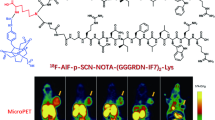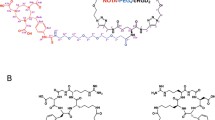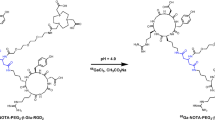Abstract
CD13 receptor plays a critical role in tumor angiogenesis and metastasis. We therefore aimed to develop 99mTc-labeled monomeric and dimeric NGR-containing peptides, namely, NGR1 and NGR2, for SPECT imaging of CD13 expression in HepG2 hepatoma xenografts. Both NGR-containing monomer and dimer were synthesized and labeled with 99mTc. In vivo receptor specificity was demonstrated by successful blocking of tumor uptake of 99mTc-NGR dimer in the presence of 20 mg/kg NGR2 peptide. Western blot and immunofluorescence staining confirmed the CD13 expression in HepG2 cells. The NGR dimer showed higher binding affinity and cell uptake in vitro than the NGR-containing monomer, presumably due to a multivalency effect. 99mTc-Labeled monomeric and dimeric NGR-containing peptides were subjected to SPECT imaging and biodistribution studies. SPECT scans were performed in HepG2 tumor-bearing mice at 1, 4, 12, and 24 h post-injection of ~7.4 MBq tracers. The metabolism of tracers was determined in major organs at different time points after injection which demonstrated rapid, significant tumor uptake and slow tumor washout for both traces. Predominant clearance from renal and hepatic system was also observed in 99mTc-NGR1 and 99mTc-NGR2. In conclusion, monomeric and dimeric NGR peptide were developed and labeled with 99mTc successfully, while the high integrin avidity and long retention in tumor make 99mTc-NGR dimer a promising agent for tumor angiogenesis imaging.







Similar content being viewed by others
References
Arap W, Pasqualini R et al (1998) Cancer treatment by targeted drug delivery to tumor vasculature in a mouse model. Science 279(5349):377–380
Bhagwat SV, Lahdenranta J et al (2001) CD13/APN is activated by angiogenic signals and is essential for capillary tube formation. Blood 97(3):652–659
Chen K, Conti PS (2010) Target-specific delivery of peptide-based probes for PET imaging. Adv Drug Deliv Rev 62(11):1005–1022
Chen X, Tohme M et al (2004) Micro-PET imaging of alphavbeta3-integrin expression with 18F-labeled dimeric RGD peptide. Mol Imaging 3(2):96–104
Chen K, Sun X et al (2012) Evaluation of (6)(4)Cu labeled GX1: a phage display peptide probe for PET imaging of tumor vasculature. Mol Imaging Biol 14(1):96–105
Corti A, Ponzoni M (2004) Tumor vascular targeting with tumor necrosis factor alpha and chemotherapeutic drugs. Ann N Y Acad Sci 1028:104–112
Corti A, Giovannini M et al (2010) Immunomodulatory agents with antivascular activity in the treatment of non-small cell lung cancer: focus on TLR9 Agonists, IMiDs and NGR-TNF. J Oncol 2010:732680
Curnis F, Arrigoni G et al (2002) Differential binding of drugs containing the NGR motif to CD13 isoforms in tumor vessels, epithelia, and myeloid cells. Cancer Res 62(3):867–874
Dijkgraaf I, Yim CB et al (2011) PET imaging of alphavbeta(3) integrin expression in tumours with (6)(8)Ga-labelled mono-, di- and tetrameric RGD peptides. Eur J Nucl Med Mol Imaging 38(1):128–137
Gregorc V, Zucali PA et al (2010) Phase II study of asparagine-glycine-arginine-human tumor necrosis factor alpha, a selective vascular targeting agent, in previously treated patients with malignant pleural mesothelioma. J Clin Oncol 28(15):2604–2611
Kessler T, Schwoppe C et al (2008) Generation of fusion proteins for selective occlusion of tumor vessels. Curr Drug Discov Technol 5(1):1–8
Lei H, Cao P et al (2010) Expression and functional characterization of tumor-targeted fusion protein composed of NGR peptide and 15-kDa actin fragment. Appl Biochem Biotechnol 162(4):988–995
Lily Adar YS, Journoa Gal, David Ayelet (2011) Pro-apoptotic peptide-polymer conjugates to induce mitochondrial-dependent cell death. Polym Adv Technol 22:199–208
Meng J, Yan Z et al (2007) High-yield expression, purification and characterization of tumor-targeted IFN-alpha2a. Cytotherapy 9(1):60–68
Ndinguri MW, Solipuram R et al (2009) Peptide targeting of platinum anti-cancer drugs. Bioconjug Chem 20(10):1869–1878
Negussie AH, Miller JL et al (2010) Synthesis and in vitro evaluation of cyclic NGR peptide targeted thermally sensitive liposome. J Control Release 143(2):265–273
Oostendorp M, Douma K et al (2008) Quantitative molecular magnetic resonance imaging of tumor angiogenesis using cNGR-labeled paramagnetic quantum dots. Cancer Res 68(18):7676–7683
Pasqualini R, Koivunen E et al (2000) Aminopeptidase N is a receptor for tumor-homing peptides and a target for inhibiting angiogenesis. Cancer Res 60(3):722–727
Petrovic N, Schacke W et al (2007) CD13/APN regulates endothelial invasion and filopodia formation. Blood 110(1):142–150
Ruggiero A, Brader P et al (2010) Different strategies for reducing intestinal background radioactivity associated with imaging HSV1-tk expression using established radionucleoside probes. Mol Imaging 9(1):47–58
Santoro A, Rimassa L et al (2010) Phase II study of NGR-hTNF, a selective vascular targeting agent, in patients with metastatic colorectal cancer after failure of standard therapy. Eur J Cancer 46(15):2746–2752
Schwoppe C, Kessler T et al (2010) Tissue-factor fusion proteins induce occlusion of tumor vessels. Thromb Res 125(Suppl 2):S143–S150
van Hensbergen Y, Broxterman HJ et al (2004) Reduced growth, increased vascular area, and reduced response to cisplatin in CD13-overexpressing human ovarian cancer xenografts. Clin Cancer Res 10(3):1180–1191
van Laarhoven HW, Fiedler W et al (2010) Phase I clinical and magnetic resonance imaging study of the vascular agent NGR-hTNF in patients with advanced cancers (European Organization for Research and Treatment of Cancer Study 16041). Clin Cancer Res 16(4):1315–1323
von Wallbrunn A, Waldeck J et al (2008) In vivo optical imaging of CD13/APN-expression in tumor xenografts. J Biomed Opt 13(1):011007
Wu Y, Zhang X et al (2005) Micropet imaging of glioma integrin {alpha}v{beta}3 expression using (64)Cu-labeled tetrameric RGD peptide. J Nucl Med 46(10):1707–1718
Yang YS, Zhang X et al (2006) Comparative in vitro and in vivo evaluation of two 64Cu-labeled bombesin analogs in a mouse model of human prostate adenocarcinoma. Nucl Med Biol 33(3):371–380
Yokoyama Y, Ramakrishnan S (2005) Addition of an aminopeptidase N-binding sequence to human endostatin improves inhibition of ovarian carcinoma growth. Cancer 104(2):321–331
Zhang Z, Harada H et al (2005) Aminopeptidase N/CD13 targeting fluorescent probes: synthesis and application to tumor cell imaging. Peptides 26(11):2182–2187
Zhao BJ, Ke XY et al (2011) The antiangiogenic efficacy of NGR-modified PEG-DSPE micelles containing paclitaxel (NGR-M-PTX) for the treatment of glioma in rats. J Drug Target 19(5):382–390
Acknowledgments
This work was supported by the National Natural Science Foundation of China (Grant No. 30970847, 30800275, 30970846), the Program of the National Basic Research and Development Program of China (Grant No. 2011CB707704), and the Major Program of National Natural Science Foundation of China (Grant No. 81090274).
Author information
Authors and Affiliations
Corresponding author
Additional information
Wenhui Ma and Fei Kang contributed equally to this work.
Rights and permissions
About this article
Cite this article
Ma, W., Kang, F., Wang, Z. et al. 99mTc-labeled monomeric and dimeric NGR peptides for SPECT imaging of CD13 receptor in tumor-bearing mice. Amino Acids 44, 1337–1345 (2013). https://doi.org/10.1007/s00726-013-1469-1
Received:
Accepted:
Published:
Issue Date:
DOI: https://doi.org/10.1007/s00726-013-1469-1




